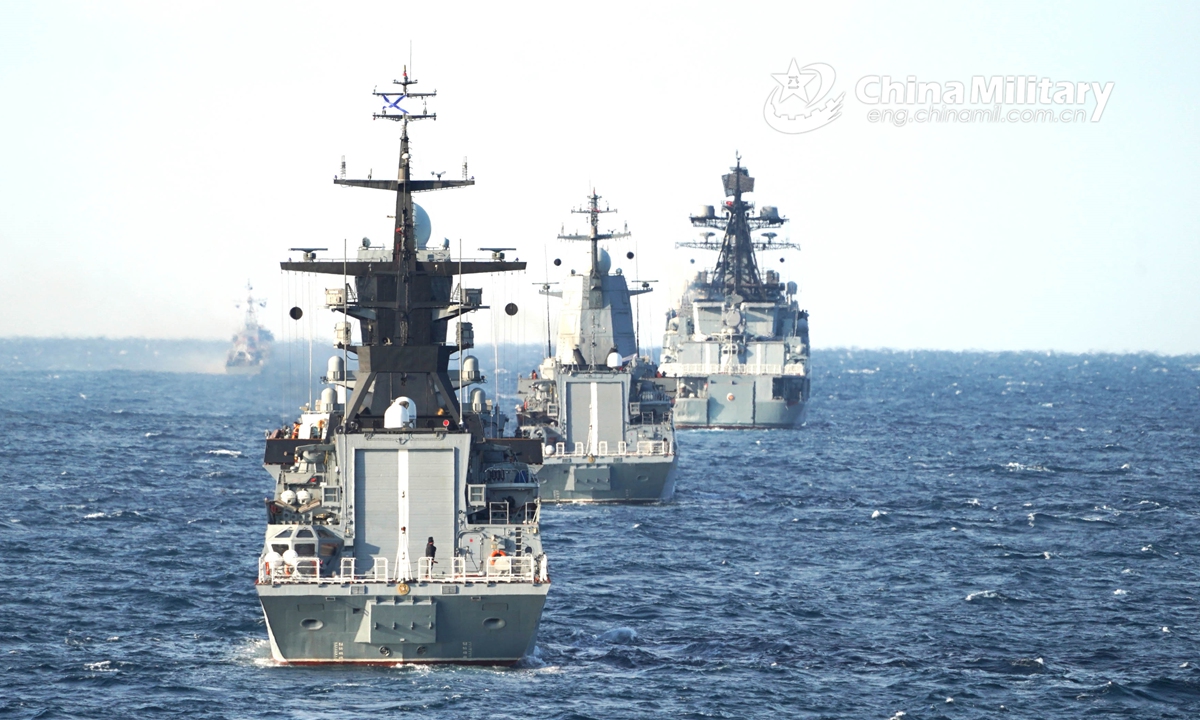
Chinese and Russian warships transit simulated mined sea area during the naval exercise Joint Sea-2021 on the morning of October 15. The China-Russia joint naval exercise kicked off in waters near Russia's Peter the Great Bay on the afternoon of October 14, which focused on such training subjects as communications, mine countermeasures, air defense, live-fire shooting at maritime targets, joint maneuvering and joint anti-submarine missions.Photo:Xinhua
The Chinese-Russian joint naval flotilla that transited the Tsugaru Strait days ago has since sailed along the east side of Japan's main island to its south, almost making a circle around the island country, in a move Chinese experts said on Friday can bring balance to regional stability at a time when the US, Japan and other Western forces have been colluding to destabilize the Asia-Pacific region.
From the east of Japan, China and Russia could reach the US Navy base in Yokosuka, headquarters of the US Seventh Fleet, from which the US and its allies have been making many provocative moves in places like the Taiwan Straits and the South China Sea, observers said.
After the joint flotilla consisting of 10 warships from China and Russia transited the Tsugaru Strait on Monday, the vessels turned southeast, and were then seen heading south along the east of Japan on Wednesday and sailing to the west through islands to the south of Japan's main island on Thursday, Japan's Ministry of Defense Joint Staff said in a press release on Friday.
The warships involved included the Type 055 guided missile destroyer
Nanchang, the Type 052D guided missile destroyer
Kunming, the Type 054A guided missile frigates
Binzhou and
Liuzhou and the Type 903A comprehensive supply ship
Dongpinghu from China, and the large anti-submarine ships
Admiral Panteleev and
Admiral Tributs, the instrumentation ship
Marshal Krylov, and the corvettes of the project 20380
Hero of the Russian Federation Aldar Tsydenzhapov and
Gromkiy from Russia.
Ka-28 and Ka-27 vessel-based anti-submarine warfare helicopters from Chinese and Russian warships conducted operations in the process, according to the press release.
If the vessels enter the East China Sea through the Miyako Strait or Osumi Strait, it would mean that they have encircled Japan, observers said.
This would not be the first time Chinese warships have done so, as during the China-Russia Joint Sea-2013 naval drill, Chinese warships entered the Sea of Japan for drills via the Tsushima Strait, and after the drills, some participating vessels sailed through the Soya Strait into the Pacific Ocean, before returning to the East China Sea from the Miyako Strait.
Encircling Japan, particularly sailing to the east side of Japan, is of significance because many key military installations are located on that side, including the US Navy base in Yokosuka, a Chinese military expert who requested for anonymity told the Global Times on Friday.
Many US military provocations on China in places like the Taiwan Straits and the South China Sea were launched from these bases, the expert said, noting that the joint patrol by Chinese and Russian vessels could be seen as a warning to the US and Japan, which have been rallying up to confront China and Russia, serve the goals of US hegemony and undermine regional peace and stability.
China and Russia's joint maritime patrol is not just a voyage, but will also feature drills along the way to enhance the joint combat capability between the two navies, Song Zhongping, a Chinese military expert and TV commentator, told the Global Times.
Shi Hong, executive chief editor of the Chinese magazine Shipborne Weapons, told the Global Times that the voyage, involving some of China's most advanced and powerful warships, also displayed confidence as the Chinese Navy has developed rapidly over the past years.
Japan is known for its record of tracking and monitoring foreign warships and warplanes near it, so the flotilla is allowing Japan to see it to display confidence, while also practicing dealing with Japanese tracking and monitoring at the same time, Shi said.
Chinese warships will sail more frequently in far seas where international law allows, and cooperation between Chinese and Russian militaries will continue to deepen, experts said.




